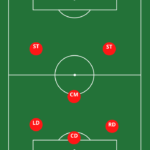- Last Updated -
History of UEFA Champions League – Let’s dive in
The Union of European Football Associations (UEFA) Champions League is more than just a football tournament; it represents the apex of European club football, a summit where only the finest football teams compete for glory.
Its illustrious history stretches back to 1955, birthed from the vision of creating a competition that would pit the champions of European domestic leagues against each other.
Today, it stands as an unrivaled spectacle in club football, dazzling millions worldwide with its blend of skill, strategy, and thrilling unpredictability. Every year, titanic clubs graced by exceptional talents lock horns under the floodlights in many an iconic stadium.
From Real Madrid’s Santiago Bernabeu to Manchester United’s Old Trafford and Bayern Munich’s Allianz Arena – these dramatic venues provide the backdrop for epic duels that leave fans captivated and opponents vanquished. The UEFA Champions League is not merely about winning or losing; it is about gaining immortality in the annals of football history.

The Indomitable Essence: Importance and Significance of UEFA Champions League
In terms of prestige, nothing surpasses lifting ‘the cup with big ears’, as affectionately named by fans referencing its distinctive handle design. Winning this trophy signifies achieving pinnacle success in club football—a validation that echoes across continents etching players’ names into eternal fandom lore.
It is a beacon signifying excellence, embodying not just sporting prowess but also strategic acumen and mental strength. The UEFA Champions League serves as an electrifying platform for players to demonstrate their abilities against world-class opposition.
Many careers have been made under its luminescence while some have faced harsh illumination revealing flaws previously unseen or hidden beneath less penetrating scrutiny. Beyond individual level, considerations stand more substantial associations between clubs’ performance within UEFA competitions and their financial prosperity.
Achieving consistent success within this league can drive significant revenue through commercial sponsorships and lucrative broadcasting rights—often serving as substantial lifelines for clubs navigating precarious financial landscapes.
Rounding off its significance on a societal level—it binds together diverse communities across geographical boundaries into passionate support units driven by shared love for teams/players illuminated on this grand stage—highlighting how football transcends beyond mere sport into a sphere capable of uniting varied societies together through shared emotional investment.

Early Beginnings: The Genesis of a Football Legend (1955-1960)
The Birth of the European Cup
The inception of the UEFA Champions League, then known as the European Champion Clubs’ Cup, or simply the European Cup, can be traced back to the mid-1950s.
It was a grand experiment driven by a desire to create an annual continental club football competition that would pit Europe’s top-performing teams against each other. This ambitious initiative was birthed in 1955 by French sports journalist and editor of L’Equipe, Gabriel Hanot.
Despite initial resistance from some quarters – notably England’s Football Association – Hanot’s brainchild received enough support to become a reality. His concept was captivating; it presented an opportunity for clubs to not only bask in domestic glory but also shine on an international platform.
The idea was that such pan-European exposure would draw larger audiences and elevate football to unprecedented heights. Gabriel Hanot’s vision materialized into what we today celebrate as the UEFA Champions League.
However, before reaching its current status, it had humble beginnings as the European Cup: a straightforward knockout competition where competing teams strived towards lifting that all-important trophy. With every victory, clubs earned their right to stay in this competition until they either won or were eliminated.
The first iteration of this tournament took place in 1955/56 season and involved 16 teams from Europe’s most prestigious leagues battling for supremacy. This innovative conception brought together countries scattered across geographical boundaries through their shared love for football while fostering companionship amidst fierce competition.
Founding Members & First Tournament Details
The inaugural European Cup included powerhouse names such as Real Madrid from Spain, AC Milan from Italy, and Stade de Reims from France who were among the 16 founding members. These clubs were selected based on their excellence domestically coupled with favorable consideration from notable journalists.
This inaugural tournament ran from September 1955 until May 1956 and adhered strictly to the home-and-away leg play-off system until the semi-finals when two-legged matches ensued culminating in a one-off final held at Parc des Princes stadium in Paris. Participating teams advanced based solely on aggregate goal count during both home and away matches thus ramping up excitement levels for spectators worldwide.
A conspicuous feature of this initial tournament was that it lacked English representation due to its Football Association’s reluctance; they disapproved seeing it as potentially distracting clubs’ focus away from domestic competitions which could hamper overall performance levels within England’s league system. Despite FA’s reservations though, the first edition turned out successful beyond expectations showcasing extraordinary talents and producing breathtaking matches and thoroughly entertaining audiences which ultimately solidified the foundation upon which today’s UEFA Champions League rests.
Key Matches & Winners in Early Years
In light of this newfound stage set by the European Cup came brilliant exhibitions and thrilling suspense-filled football encounters making news headlines across the continent particularly the maiden final between French giants Stade de Reims and Spanish behemoth Real Madrid.
This gripping encounter saw Spanish maestros emerge victorious with Alfredo Di Stefano spearheading Madrid’s attack resulting in a memorable 4-3 victory marking the commencement La Liga side’s domination era lasting five consecutive years earning them recognition best team in the world during that specific timeframe.
Besides Real Madrid’s unmatched dominion, the first few editions also bore witness power shift towards Italian Serie A after the introduction of Internazionale Milan famously known then “La Grande Inter” under master tactician Helenio Herrera won titles consecutively in 1964/65 seasons employing defensive yet effective “Catenaccio” style play leaving opponent teams dumbfounded unable to penetrate their iron-clad defense strategy.
This period also saw the emergence of individual phenomenons like Francisco Gento who holds the record being only player wins six Champion Clubs’ cups Eusebio Portugal whose exploits Benfica landed them two consecutive finals winning one setting precedence for future generations follow ensuring legacy early years engraved history books forever.

Evolution and Expansion (1960-1992): Dynamism in the European Football Landscape
A New Era: Changes in Format and Expansion to More Teams
The 1960s marked an era of evolution and expansion for the European Cup. The competition began to open its doors to multiple representatives from each country, thereby extending its reach beyond just the champions of every national league.
This decision was a result of strategic deliberations that aimed to increase the level of competition, thus enhancing the tournament’s quality and appeal.
In 1967, Scottish club Celtic became the first British team to clinch the title, highlighting how this liberalization policy was starting to bear fruit. With additional teams joining from each participating country, a new format was introduced in 1977 that included quarter-final and semi-final second-leg matches being played at home venues instead of on neutral grounds.
A further landmark change came in 1986 when UEFA decided that runners-up from certain countries could participate. This move not only increased competition but also expanded opportunities for clubs across Europe, fostering an inclusive atmosphere where both established powerhouses and ambitious newcomers could thrive.
The changing format also saw a shift towards more knockout phases rather than group stages to accommodate growing participation numbers. By promoting more competitive matches at every stage of play, UEFA ensured an escalating crescendo of excitement as teams battled their way toward the coveted final spot.
Dominance Redefined: Certain Clubs Rule this Era
The period between 1960-1992 witnessed an interesting power play among clubs vying for supremacy on Europe’s biggest football stage. Real Madrid’s dominance gradually paved the way for other clubs like Internazionale and AC Milan from Italy who proved their mettle with successive victories during this period.
However, it was during these years that certain clubs truly shaped their legacy. Liverpool FC emerged as one formidable force from England winning four titles between 1977-1984 under ace manager Bob Paisley.
Similarly, Ajax Amsterdam lit up Dutch football with three consecutive triumphs (1971-73) employing the Total Football philosophy under legendary Rinus Michels. Bayern Munich too started building its stronghold over European football by winning three titles consecutively (1974-76).
Not far behind were AC Milan and Juventus who kept Italy’s flag flying high during this era with multiple victories symbolising Serie A’s influence over European club football. This era ended on a high note with FC Barcelona finally clinching their maiden title after years of anticipation in 1992 under Johan Cruyff – a victory which catalyzed a future rich in success at the continental level for Catalan giants.”
Saga Unfolds: Memorable Matches, Players, And Incidents
This enriching epoch witnessed some sterling matches etched forever in collective memory due to their sheer grandeur or dramatic finishes. Who can forget Aston Villa’s unexpected triumph over Bayern Munich in Rotterdam (1982) or Hamburg’s denial against much fancied Juventus led by Michel Platini (1983)?
Each match carried its unique narrative adding layers of intrigue within Europe’s premier club competition. Indeed it was players who often prove decisive factors in turning games on their heads through individual brilliance or showmanship.
Greats like Marco van Basten whose acrobatic volley secured AC Milan’s win against Steaua Bucuresti (1989), Eusebio whose prowess catapulted Benfica onto global fame are such names remembered fondly even today for leaving indelible prints on tournament history through exquisite performances during pivotal moments.” In terms of shocking incidents worth mentioning would be Heysel Stadium disaster before Liverpool-Juventus final match held in Brussels (1985).
This catastrophic event led UEFA to ban all English clubs indefinitely from all European competitions – a severe punishment severely impacting the landscape entire English club football.” Roma’s heartbreak losing out penalty shootout against Liverpool right at home stadium Stadio Olimpico Rome(1984), provided another unforgettable moment showcasing how fortunes can swing wildly within the confines ninety minutes transforming ecstasy into agony within blink eye.”

Rebranding to UEFA Champions League
Reasons for Rebranding
The European Cup underwent a significant metamorphosis in 1992, emerging as the UEFA Champions League. This rebranding was not merely cosmetic — it reflected a broader shift in Europe’s football landscape.
With the advent of television rights and lucrative sponsorship deals, there was an impetus to transform the tournament into a more marketable and globally recognisable product. Clubs were also accelerating toward professionalism, necessitating a format that accommodated more games and thus more revenue.
Introduction of Group Stages
A major innovation introduced during this rebranding was the group stage system. This allowed for an increase in matches played, offering clubs greater exposure and earning opportunities from broadcasting rights. The group stages brought anticipation and tension as teams battled each other home and away to secure one of two spots that led to the knockout stages.
Inclusion of Non-Champion Teams
Perhaps one of the most controversial aspects of the Champions League era was the inclusion of non-champion teams from certain nations. Initially met with skepticism, this strategy aimed to raise competitive standards by incorporating top-tier clubs that finished below their domestic champions but had exceptional quality.

Modern Era Developments
Inclusion and Expansion
Post-2000, we witnessed further expansion in team participation as UEFA sought to democratize access while maintaining high competitive standards. The resultant broader canvas cultivated a narrative where lesser-known clubs could challenge traditional powerhouses on an increasingly common basis.
Financial Implications: TV Rights, Sponsorships, etc.
Modern era developments have also been characterized by profound financial implications with stratospheric broadcast deals and sponsorship investments driving club revenues skyward. An elite cadre of clubs now enjoys unprecedented wealth due largely to their consistent visibility on this grand stage.
Dominant Teams, Players & Coaches
This era has witnessed several dominant teams carving out their legacy in Europe’s premier competition – Real Madrid’s three consecutive titles from 2016-2018 stands out significantly. It has also been shaped by iconic players like Messi or Ronaldo, whose exploits have added lustre to their respective club’s European narratives; alongside master tacticians like Guardiola or Klopp who have left indelible marks on modern football concepts through their coaching prowess on this platform.
Iconic Moments in UEFA Champions League History
From heart-stopping comebacks to last-minute drama – few tournaments can compete with the storied history etched onto the canvas of time that is the UEFA Champions League. One such storied event is Liverpool’s ‘Miracle at Istanbul’ during the 2005 final when they defied all odds by overturning a three-goal deficit against AC Milan at half-time – arguably one of greatest comeback stories ever told in sport’s history.
No less dramatic was Manchester United’s last-minute victory against Bayern Munich in the 1999 final which invoked unimaginable ecstasy amongst supporters as they snatched victory from jaws of defeat within course few fateful extra-time minutes. In more recent times we’ve marveled at Barcelona’s historic treble wins – feats achieved twice over under reigns of different charismatic coaches (Guardiola ’09 & Enrique ’15), a testament to both versatility Catalan giants ability consistently churn out world-class talent across generations while retaining distinct identity style play.
The Future Of UEFA Champions League
In terms of future format changes proposed Super League controversy looms large over the tournament although these proposals have met overwhelming opposition across the board which might just act catalyst for preserving the essence traditional football competition structure. Undoubtedly impact of smaller leagues/clubs remains a key concern amidst potential future changes, particularly the imbalance of resources which feeds into a widening chasm between haves and have-nots European football landscape.
However, despite challenges beautiful game continues to evolve so too will its premier competition ensuring it remains the pinnacle club of football across the globe engrossing fans every passing season delivering spectacular skill drama passion unrivaled in any other sports event world over.
The Champions League has come a long way since its inception back in 1955 – evolving resonating with millions worldwide crafting tales human spirit and resilience defining careers and icons game inspiring generations of budding footballers relentlessly drawing awe-admiration lovers of beautiful game alike – testament enduring appeal vitally important role plays fostering unity diversity expression through language global football. The references are available upon request.
Concussion Substitutions in Soccer: evolving concussion protocols
The Growing Concern for Player Safety in Soccer Soccer, a beloved sport...
Read More


















